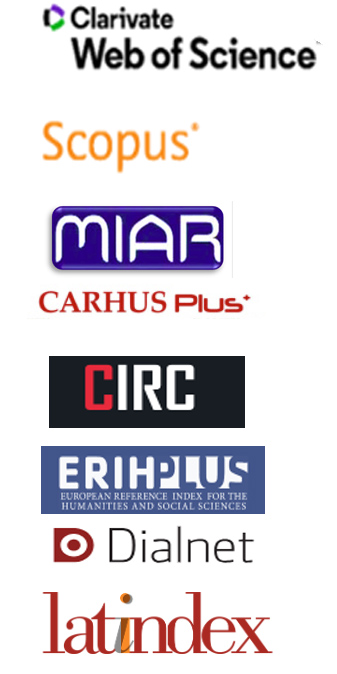The use of a virtual image as a step to the aesthetic presentation of an overpainted baroque painting
Resumen
La tecnología se ha convertido en una parte importante del trabajo del conservador, y todavía estamos aprendiendo cómo usarla en su totalidad para las mejores prácticas. El principal problema es la falta de tiempo para el tratamiento del patrimonio cultural y el conocimiento insuficiente en el campo de la tecnología. En este artículo, presentamos el uso de una imagen virtual como ayuda para restaurar la pintura Mater Dolorosa del famoso pintor barroco esloveno Marko Layer. El complejo estado de conservación de la pintura indica la necesidad de un enfoque diferente al implementar los procedimientos. La documentación gráfica de las áreas que debían eliminarse y reintegrarse se realizó para que fuera posible tener una visión transparente del trabajo que siguió. Para ayudar con la eliminación y el proceso de reintegración, se hizo una imagen virtual de la pintura reintegrada con sus opciones. El objetivo fue comprender mejor las especificaciones de la pintura. Durante la ejecución de la imagen virtual, la pintura se investigó en detalle para aplicar correctamente la teoría a la práctica.
Descargas
Citas
AMBROŽIČ, N. (2013). Odstranjevanje laka in preslikav na sliki Marka Layerja Mater Dolorosa. Diplomsko delo. Ljubljana: University of Ljubljana.
BARNI, M.; BARTOLINI F.; CAPPELLINI, V. (2000). “Image processing for virtual restoration of artworks”, IEEE Multimedia, 7: 34-37, https://doi.org/10.1109/93.848424.
BATIHA, K., AL-SALAIMEH, S., BESOUL, K. (2007). “Digital Art and Design”, International Journal Information Technologies and Knowledge, 1: 147-151, http://hdl.handle.net/10525/245.
BUZZANCA, G. (2000). “A User-friendly Approach (... More About Standards and Customized Menus in Digital Recording of Condition)”. In GraDoc, Graphic Documentation Systems in Mural Painting Conservation, Schmid, W. (ed.), Rome: ICCROM, 147-159.
KAVKLER, K., JUVAN, P., PRESTOR, M. (2012). Marko Layer, Mater Dolorosa, Narodna galerija: poročilo naravoslovnih preiskav. Ljubljana: Zavod za varstvo kulturne dediščine, Restavratorski center.
LIMONCELLI, M., SCHEPIS, L., GERMINARIO C. (2017). Virtual Restoration. Paintings and mosaics. Rome: «L’ERMA» di BRETSCHNEIDER.
MACBETH, R. (2012). “The technical examination and documentation of easel paintings”. In Conservation of Easel Paintings, Rushfield, R., (ed.). London: Routledge, 291-305.
MOORE, M. (2001).“Conservation Documentation and the Implications of Digitisation”. Journal of Conservation and Museum Studies, 7: 6-10, http://doi.org/10.5334/jcms.7012.
SAUNDERS, D., CUPITT, J., PADFIELD J. (2006). “Digital Imaging for Easel Paintings”. In Digital Heritage: Applying Digital Imaging to Cultural Heritage, Macdonald, L., (ed.), Amsterdam etc.: Butterworth-Heinemann / Elsevier, 521-547.
STERLE, A. (2019). Estetska prezentacija preslikane baročne slike Mater Dolorosa Marka Layerja. Diplomsko delo. Ljubljana: University of Ljubljana.
STOLS-WITLOX, M., ORMSBY, B., GOTTSEGENIN, M. (2012). “Grounds 1400–1900 and Twentieth-century grounds”. In Conservation of Easel Paintings, Rushfield, R. (ed.). London: Routledge, 161-188.
RENÉ DE LA RIE, E., QUILLEN LOMAX, S., PALMER, M., DEMING G., MAINES, C. A. (2000). “An investigation of the photochemical stability of urea-aldehyde resin retouching paints: removability tests and colour spectroscopy”, Studies in Conservation, 45: 51-59, https://doi.org/10.1179/sic.2000.45.Supplement-1.51.
- Los autores conservan los derechos de autor y propiedad intelectual, y garantizan a la revista Ge-Conservación y al GEIIC el Copyright© de los derechos de edición y publicación por cualquier medio y soporte. Las obras de dichos autores además se pueden publicar bajo una Creative Commons Attribution License que autoriza ser distribuido gratuitamente, copiado y exhibido por terceros si se muestra en los créditos la autoría y procedencia original en esta revista, y no se puede obtener ningún beneficio comercial por parte de terceros, ni tampoco se pueden realizar obras derivadas.
- Los artículos podrán ser utilizados para fines científicos y formativos, pero nunca con fines comerciales, expresamente sancionado por la Ley.
- La información contenida en los artículos es responsabilidad exclusiva de los autores.
- La revista Ge-Conservación y los autores pueden establecer por separado acuerdos adicionales para la distribución no exclusiva de la versión de la obra publicada en la revista (por ejemplo, situarlo en un repositorio institucional o publicarlo en un libro), con un reconocimiento de su publicación inicial en esta revista.
- Se permite y se anima a los autores a difundir sus trabajos electrónicamente (por ejemplo, en repositorios institucionales o en su propio sitio web) después de su publicación en la revista Ge-Conservación, ya que puede dar lugar a intercambios productivos, así como a una citación más temprana y mayor de los trabajos publicados por el autor.
- Los datos personales suministrados por los autores únicamente serán utilizados para los fines de la revista y no serán proporcionados a terceros.









